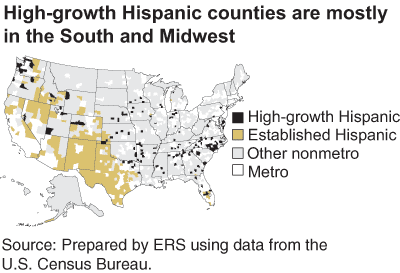Hispanics Find a Home in Rural America
- by William Kandel and John Cromartie
- 2/3/2003
Hispanics are the fastest growing segment of the American population, and this growth is especially striking in rural America. The 2000 census shows that Hispanics accounted for only 5.5 percent of the Nation's nonmetro population, but 25 percent of nonmetro population growth during the 1990s. Many counties throughout the Midwest and Great Plains would have lost population without recent Hispanic population growth. Among nonmetro counties with high Hispanic population growth in the 1990s, the Hispanic growth rate exceeded 150 percent, compared with an average growth rate of 14 percent for non-Hispanics. Moreover, Hispanics are no longer concentrated in Texas, California, and other Southwestern States—today nearly half of all nonmetro Hispanics live outside the Southwest.
Residential segregation is an important measure of assimilation, because it reflects the ability of newcomers to integrate socially and economically with the native population. ERS researchers evaluated segregation patterns in metro and nonmetro America using 1990 and 2000 census population data to calculate the Dissimilarity Index, an established measure of relative population distribution between two groups. Nationally, the Hispanic population is clearly more dispersed throughout regions, States, and counties than ever before, the result of migration patterns changing from destinations in the Southwest to those in the South and Midwest. Decreases in the Dissimilarity Index between Whites and Hispanics across all nonmetro U.S. counties reflect this growing dispersion. However, at the neighborhood level, a different picture emerges. Residential segregation increased over the decade, with the largest increases occurring in nonmetro counties experiencing high Hispanic population growth. While neighborhood-level segregation in U.S. metro counties exceeded that of high-growth nonmetro counties in 1990, the reverse was true by 2000.
Rural population growth and increasing residential segregation have significant implications for economic development and socioeconomic inequality. Hispanic population growth in rural areas often coincides with revived economies from expanded manufacturing, increased recreation and tourism, and growing retirement destinations. However, relatively sudden influxes of ethnic-minority, low-wage workers and their families can overwhelm rural school systems, depress local wages, increase demand for social services, and contribute to income inequality and residential segregation. The extent to which Hispanic inmigrants integrate spatially within a community directly affects their interaction with the community as well as native attitudes toward ethnic and racial diversity. If Hispanic neighborhoods become increasingly segregated, they will likely experience declining access to retail centers, growing dependence on government assistance, underfunded schools and social services, and transportation barriers to employment. Future population shifts, low-wage job availability, skill upgrading, and State and community-level support programs will affect the degree to which Hispanics assimilate in rural America.
You may also like:
- Rural Economy & Population. (n.d.). U.S. Department of Agriculture, Economic Research Service.



